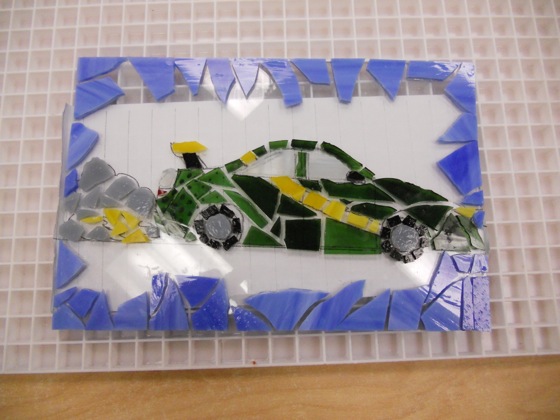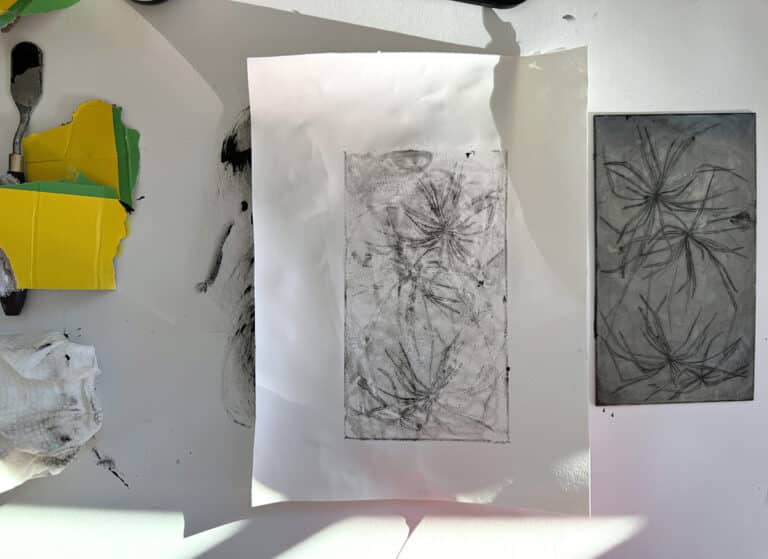It’s no surprise the cost of art supplies can cause road blocks in curriculum development. Art teachers often have to prioritize what supplies are the most cost effective, sometimes purchasing quantity over quality. With a very limited budget, sometimes purchasing specialty supplies like glass is out of the question. The good news is, there are many other creative ways to work around your already allocated, limited art budget to purchase glass for the art room.
I’m excited to share some creative ways art teacher, Jennifer Knusch, funds glass projects in her art room. Jennifer teaches high school art classes to students in grades 9-12 in a suburb of Chicago. There are about 2,700 students at her school. She has a lot of experience using glass and has some excellent ideas to supplement cost and incorporate glass into your art curriculum.
How did you get started using glass in your art program?
I met a representative from Ed Hoy’s International and they taught me everything I needed to get started on an entry level. I was able to get the new materials added into my curriculum by building on what I was already teaching, but making it more exciting for the students using glass. I created lesson plans talking about glass and its coefficient. This all falls under science. I started with little manual hot boxes. After the administration realized how much time this took away from instruction, and the class was filling up, they decided to invest in a larger kiln. Over the years I’ve added to my collection of kilns by doing fundraisers to assist with the growing popularity.

My students and I experiment with the materials and discover new techniques. Over the years I’ve been able to take classes at Ed Hoy’s International to keep updated on new materials and techniques.
What are some of your most successful projects you’ve done?
Mosaics seem to be a real hit with the kids. If they could, they would mosaic their entire bedroom!

For my level one class, I teach basic glass fusing with a hot kiln. We learn how different temperatures melt the glass and impact the surface of the glass; if it has texture or smooth (full or tack fuse). They make pendants for the hot work. Then we make small mosaics with scrap glass and they learn how to use tile nippers to chip the glass. We talk about the elements and principles of design and they make a 2D glass mosaic. They learn about how to cut the glass to create movement and rhythm. I explain how the edge of the glass creates line and the break lines are very important to create shape.
My level two class builds on the learning of level one. They learn different glass products on the market for fusing in the kiln lidecals, frit, and high fire wire. I teach them how to melt glass over bisque fired clay, slumping and how to use the grinder and wet saw to alter their fused projects. We make larger mosaics by applying scrap glass onto found objects from goodwill or the thrift store. Then we move on to working with the torch and make glass beads.
In my AP I course have the kids do research and find a technique of working with hot or cold glass. This allows them to further their learning at a higher level.

What are the students’ reactions to using glass?
At first they are not sure how to visually see the results so I keep it simple. Once they get past two or three firings or projects, they really start to experiment.
How do you supplement the costs of using these materials?
The students pay a lab fee of $35.00. Along with this, I do teacher workshops on fusing and charge them a fee after school to make holiday pendants. Two years ago I sold melted wine bottles as a cheese board and made $500.00. This money bought my sanitizer for safety glasses.
What advice do you have to teachers who want to incorporate glass into their curriculum and funding is an issue?
I would start small and look into writing grants or looking for donations. An after-school Art Club would be a small enough group of students to figure out how to teach fusing. One way to raise funds is to sell pendants around the holidays with this group. Using glass in school colors is a big hit with teachers and they love the glass projects that the kids make.
Do you teach a specific glass class or do you integrate it into your curriculum?
I integrate glass into my curriculum. About 10 years ago another teacher in my department started up a Jewelry Class (stringing beads) and had a few lessons with glass. This included Fusing glass with a kiln (hot work), bead making with map gas and glass mosaic (cold work). She moved on to the new high school in my district so I was assigned to the class without any experience. With a few intro. lessons on how to work with glass and reading a few instruction books, I figured out what intrigued the students and developed what I teach currently over the 10 years. I now renamed the class to Jewelry, Glass & Fiber Art.
Do you use a special kiln for your projects? Can ceramic kilns be used instead of a glass kiln?
It’s okay to start small. I put in a lot of personal time working with very small kilns and worked my way up. I have a variety of kilns but a ceramic kiln works just fine for the teacher who doesn’t have the funds or access to get a glass kiln. There are firing charts available to fuse glass in a ceramic kiln.
Thank you Jennifer for sharing your experiences with us! I don’t know about you, but I am optimistic that there will be some glass melted in my kiln in the near future. Like Jennifer said, don’t be afraid to start small.
AOE Readers, weigh in- What other questions do you have about incorporating glass into your curriculum?
Do you have any other creative ways to fund glass projects?
{Photos courtesy of Jennifer Knusch and Ed Hoy’s International}
Magazine articles and podcasts are opinions of professional education contributors and do not necessarily represent the position of the Art of Education University (AOEU) or its academic offerings. Contributors use terms in the way they are most often talked about in the scope of their educational experiences.




